上海海事大学国际物流Chapter 11 International Land and Multi-Modal Transportation
- 格式:pdf
- 大小:1.62 MB
- 文档页数:36
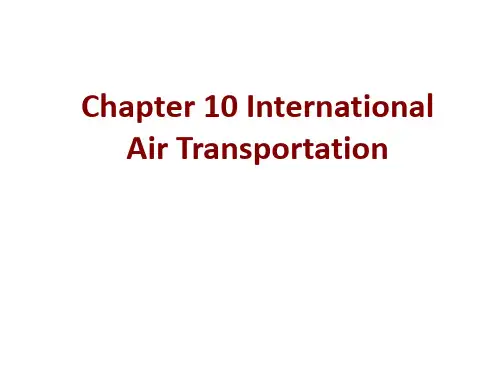
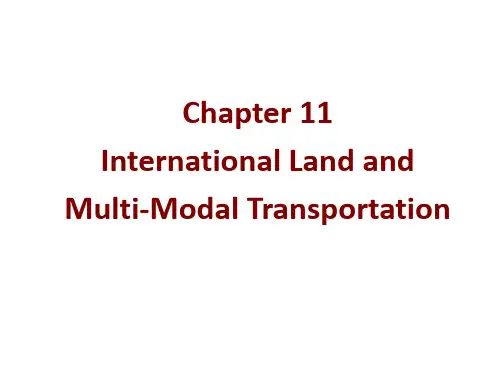
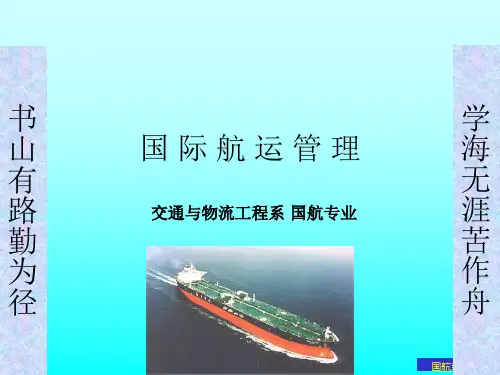
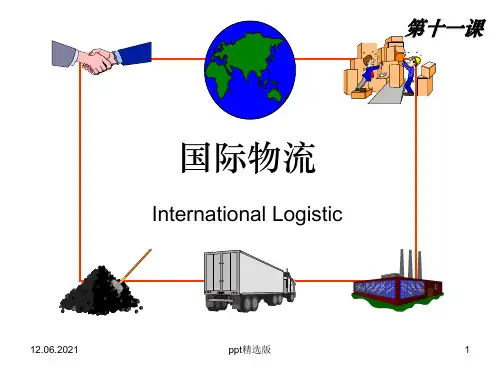
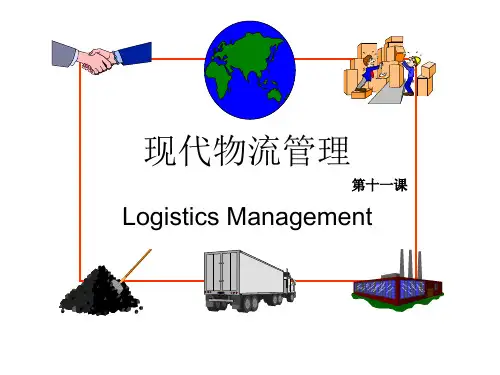
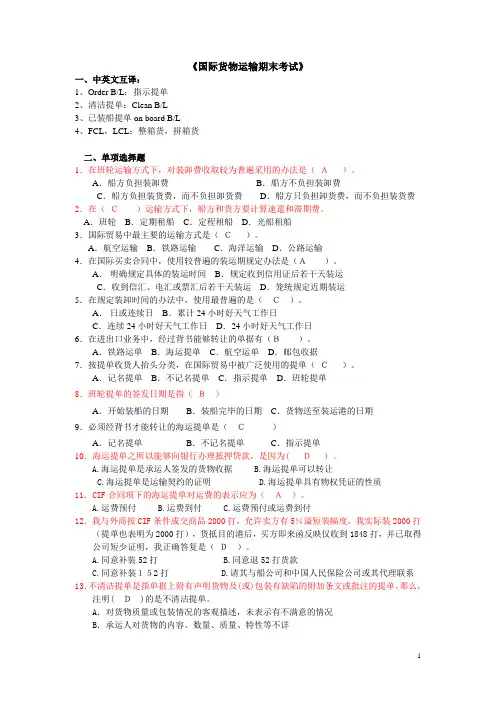
《国际货物运输期末考试》一、中英文互译:1、Order B/L:指示提单2、清洁提单:Clean B/L3、已装船提单on board B/L4、FCL,LCL:整箱货,拼箱货二、单项选择题1.在班轮运输方式下,对装卸费收取较为普遍采用的办法是(A)。
A.船方负担装卸费B.船方不负担装卸费C.船方负担装货费,而不负担卸货费D.船方只负担卸货费,而不负担装货费2.在(C)运输方式下,船方和货方要计算速遣和滞期费。
A.班轮B.定期租船C.定程租船D.光船租船3.国际贸易中最主要的运输方式是(C)。
A.航空运输B.铁路运输C.海洋运输D.公路运输4.在国际买卖合同中,使用较普遍的装运期规定办法是(A)。
A.明确规定具体的装运时间B.规定收到信用证后若干天装运C.收到信汇、电汇或票汇后若干天装运D.笼统规定近期装运5.在规定装卸时间的办法中,使用最普遍的是(C)。
A.日或连续日B.累计24小时好天气工作日C.连续24小时好天气工作日D.24小时好天气工作日6.在进出口业务中,经过背书能够转让的单据有(B)。
A.铁路运单B.海运提单C.航空运单D.邮包收据7.按提单收货人抬头分类,在国际贸易中被广泛使用的提单(C)。
A.记名提单B.不记名提单C.指示提单D.班轮提单8.班轮提单的签发日期是指(B)A.开始装船的日期B.装船完毕的日期C.货物送至装运港的日期9.必须经背书才能转让的海运提单是(C)A.记名提单B.不记名提单C.指示提单10.海运提单之所以能够向银行办理抵押贷款,是因为( D ) 。
A.海运提单是承运人签发的货物收据B.海运提单可以转让C.海运提单是运输契约的证明D.海运提单具有物权凭证的性质11.CIF合同项下的海运提单对运费的表示应为(A)。
A.运费预付B.运费到付C.运费预付或运费到付12.我与外商按CIF条件成交商品2000打,允许卖方有5%溢短装幅度,我实际装2000打(提单也表明为2000打),货抵目的港后,买方即来函反映仅收到1848打,并已取得公司短少证明,我正确答复是(D)。
![[工学]上海海事大学国际航运课件](https://uimg.taocdn.com/4a1a8da3e53a580216fcfe2f.webp)
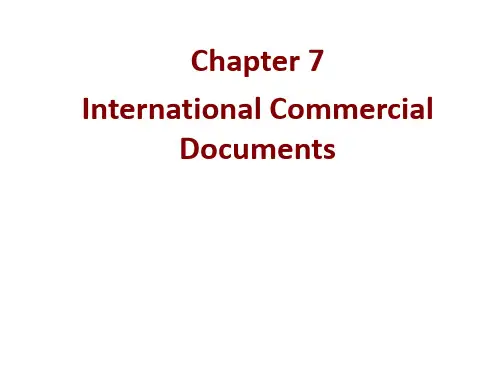
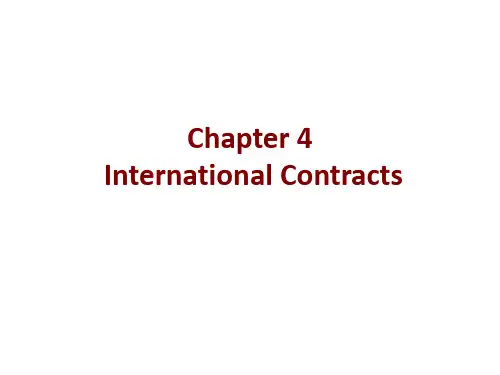
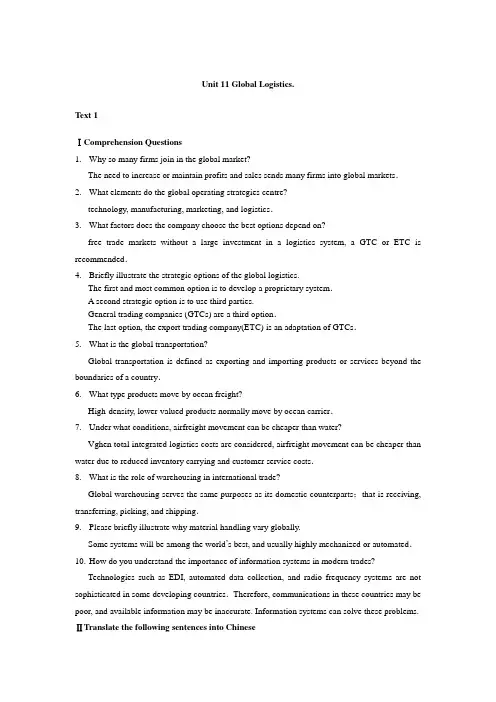
Unit 11 Global Logistics.Text 1ⅠComprehension Questions1.Why so many firms join in the global market?The need to increase or maintain profits and sales sends many firms into global markets.2.What elements do the global operating strategies centre?technology, manufacturing, marketing, and logistics.3.What factors does the company choose the best options depend on?free trade markets without a large investment in a logistics system, a GTC or ETC is recommended.4.Briefly illustrate the strategic options of the global logistics.The first and most common option is to develop a proprietary system.A second strategic option is to use third parties.General trading companies (GTCs) are a third option.The last option, the export trading company(ETC) is an adaptation of GTCs.5.What is the global transportation?Global transportation is defined as exporting and importing products or services beyond the boundaries of a country.6.What type products move by ocean freight?High-density, lower-valued products normally move by ocean carrier.7.Under what conditions, airfreight movement can be cheaper than water?Vghen total integrated logistics costs are considered, airfreight movement can be cheaper than water due to reduced inventory carrying and customer service costs.8.What is the role of warehousing in international trade?Global warehousing serves the same purposes as its domestic counterparts;that is receiving, transferring, picking, and shipping.9.Please briefly illustrate why material handling vary globally.Some systems will be among the world’s best, and usually highly mechanized or automated.10.How do you understand the importance of information systems in modern trades?Technologies such as EDI, automated data collection, and radio frequency systems are not sophisticated in some developing countries.Therefore, communications in these countries may be poor, and available information may be inaccurate. Information systems can solve these problems. ⅡTranslate the following sentences into Chinese1.The need to increase or maintain profits and sales sends many firms into globalmarkets.International trade is growing more rapidly, worldwide than domestic economies.增加或维持利润和销售的需要把企业带进了全球市场,全球贸易比国内经济增长更迅速更广泛。

国际贸易实务名词解释1海上风险:Perils of the seaPerils refers to risks which occur at sea, or at the place where the ocean and land, or the ocean and the inland river, or the ocean and the lighter are connected. The ordinary actions of the winds and waves are not included. Perils of the sea usually include Natural Calamities and Accidents.2外来风险:Extraneous RisksIt means the perils caused by other reasons except marine perils. It falls into types: General extraneous risks and Special extraneous risks.3施救费用:Sue& Labor ExpenseIt refers to the responsibility of the assured to act to keep his insured loss at a minimum. When the insured cargo suffers natural calamities or fortuitous accidents within the scope of insurance cover, the insured or his agent or any employees pays the expenses caused in saving the insured cargo in order to prevent the losses from further expanding. These charges shall be covered by the insurer.4救助费用:Salvage ChargesIt refers to compensation paid for the rescue of a ship, its cargo or passengers from a loss at sea. When the insured cargo suffers a natural calamity or an accident within the scope of insurance cover, the third party who has no contracted relations with the insured and the insurer salvages the cargo successfully. According to the relative laws, existing in the world, the insurer shall pay to the salver. The principle of “no cure-no pay” is often adopted.5实际全损:Actual Total LossIt means that the insured goods are totally suffered from loss or deteriorated, or the goods cannot be restored after being damaged. It may also refer to the fact that the title of goods cannot be owned by the insurant or the vessel has missed for quite a long time (half year for example) and with no information.6推定全损:Constructive Total LossIt is an insurance loss where the expense of recovering or repairing the insured goods would exceed their value after this expenditure had been incurred.7单独海损:Particular AverageIt means that a particular cargo is damaged by any cause and the degree of damage does not reach a total loss, which shall be borne by the owner of this individual consignment. It always refers to any other accidents except General Average, i. e. the partial loss caused directly by perils.8共同海损:General AverageIt refers to the loss which is the result of a sacrifice voluntarily made or an expense incurred; for the sole purpose of saving a ship and its cargo in face of a common danger (e. g. jettison of cargo to lighten a ship in distress). If the action taken is successful, each party to the adventure----all cargo owners and the vessel owner----bear the loss and expenses incurred based on the value of each shipment in proportion to the total value of cargo and vessel. The cargo owners whose goodsare safe and sound or uninsured in the marine perils must also contribute to pay for the loss and expenses.9平安险:Free from Particular AverageThis is a very limited cover confining the insurer’s liability, strictly speaking, to only total loss of the insured cargo except where the carrying vessel or craft is grounded, sunk or burnt, and only in such latter cases will partial loss of or damage to the cargo be answerable.10水渍险:With (Particular ) AverageIt covers partial loss due to vile weather, lightning, tsunami, earthquake and/ or flood as well as the risks covered under Free from Particular Average condition as mentioned above.11一切险:All RisksAll risks provide additional coverage besides the cover under Free from Particular Average and With (Particular) Average conditions. Contrary to its name, the clause dose not protect against all risks. The more common perils it does cover are theft, pilferage, non-delivery, fresh water damage, contamination, breakage, and leakage. Inherent vice, loss of market, and losses caused by delay are not covered.12背对背信用证:Back-to-back Letter of CreditThis is a letter of credit in the seller’s (middleman’s) favor which is offered to a bank as security for it issuing a different letter of credit in the seller’s own name to another person.13可转让信用证:Transferable Letter of CreditA transferable letter of credit is one in which the beneficiary has the right to request the paying, or negotiating bank to make either part, or all, of the credit value available to one or more third parties. This type of credit is useful for those acting as middlemen especially where there is a need to finance purchases from third party suppliers.14循环信用证:Revolving Letter of CreditThe Revolving letter of credit is used for regular shipments of the same commodity to the same buyer. It can revolve in relation to time or value. If the credit is time revolving once utilized, it is reinstated for further regular shipments until the credit is fully drawn. If the credit revolves in relation to value once utilized and paid, the value can be reinstated for further drawing. The credit must state that it is a revolving letter of credit and it may revolve either automatically or subject to certain provisions. Revolving letter of credit are useful to avoid the need for repetitious arrangements for opening or amending letters of credit.15议付信用证:Negotiation CreditA negotiating credit is opened by the issuing bank in the currency of its own country and addressed direct to the beneficiary. The letter is usually delivered to the addressee through the intermediary of correspondent bank.16对开信用证:Reciprocal CreditThis type of credit applies to barter transaction or compensation trade. Both the seller and the buyer open letters of credit in favor of each other. And the two credit s must be valid simultaneously. The applicant and beneficiary of one credit are usually the beneficiary and applicant of another credit. The opening bank is usually the advising bank of another credit.17保兑信用证:Confirmed Documentary CreditConfirmed letters of credit carry the commitment to pay of both the issuing and the advising banks. The advising banks adds its undertaking to pay to that of the issuing bank, and its commitment is independent of that of the issuing bank. Therefore, when documents conforming to the requirements of the confirmed documentary credit are presented in a timely manner, the payment from the advising to the seller is final in all respect as far as seller is concerned.18备用信用证:Standby Letters of CreditIt is a letter of credit which a bank issues on behalf of its customer to serve as a guarantee to the beneficiary of the letter of credit that the bank’s customer will perform a specified contract with the beneficiary. If the customer defaults, the beneficiary may draw funds against the letter of credit ad penalties or as payments, whichever the terms of the credit provide.19银行保函:Bank er’s Letter of GuaranteeA letter of Guarantee is an undertaking made by the guarantor bank to pay the beneficiary unconditionally according to the Letter of Guarantee provided the applicant cannot or not pay.20 D/P at sight:即期付款交单(托收)After shipment of the goods, the seller shall draw a sight bill of exchange, and send it with shipping documents to a local bank, through which and whose correspondent bank the documentary draft is presented to the buyer. The buyer shall pay against the documentary draft drawn by the seller at sight. It requires immediate payment by the buyer to get hold of the documents.21 D/P after sight:远期付款交单(托收)After shipment of the goods, the seller shall draw a usance bill of exchange and send it wih shipping documents to a local bank, through which and whose correspondent bank the documentary draft is presented to the importer. The buyer shall accept the usance draft, and make payment on the due date of the usance bill.22 D/P T/R:凭借信托收据付款(托收)In this case, the principle instructs the collecting bank to release full set of documents against trust receipt to the payer. Once the payer does not make payment, the principal bears all the risks. Thus it is almost the same risky as D/A.23 D/A:承兑交单(托收)D/A calls for delivery of documents against acceptance of the draft drawn by the seller. D/A is always after sight. In D/A terms the collecting bank is permitted to release the documents to the buyer against acceptance of a bill of exchange promising to pay at a later date (usually 30, 60 or90 days). The full set of draft is held by the collecting bank and presented to the buyer for payment at maturity, after which the collecting bank sends the funds to the remitting bank, which in turn sends them to the principal.24 T/T:电汇Telegraphic TransferTelegraphic transfer is also named as cable transfer or wire transfer.25 M/T:信汇Mail TransferThe buyer gives money to a local bank which sends a trust deed for payment to its correspondent bank at the seller’s end by mail and entrusts it with the task to pay money to the seller.26 D/D:票汇Demand DraftThe buyer buys a draft from a local bank sends it by mail to the seller, the seller or his appointed person can collect money from the relative bank at his end against the draft sent by the buyer. Demand draft is often used when the customer wants to transfer the funds to his beneficiary by himself.27 L/G:银行保函Letter of GuaranteeA letter of Guarantee is an undertaking made by the guarantor bank to pay the beneficiary unconditionally according to the Letter of Guarantee provided the applicant cannot or not pay.28清洁提单:Clean B/LThis is a B/L which bears no superimposed clause or natation which declares a defective condition of the goods and/or the packaging.29已装船提单:On Board B/L or Shipped B/LIt is a B/L acknowledging that the relative goods have been received on board for shipment on a specified vessel.30全式提单::Long Form B/LThis refers to a B/L form with all terms and conditions written on it. Most B/L’s are in short term forms which incorporate the long form clauses by reference.31简式提单:Short Form B/LIt is a B/L without the terms and conditions written on it. The terms are incorporated by reference to the long form B/L.32倒签提单:Ante-dated Bill of LadingWhen the actual loading date is later than the date of shipment prescribed by the L/C, in order to avoid non-acceptance of the B/L by banks, the carrier, at the request of the shipper, sometimes will issue a B/L with a date of signature that suits the requirement of the L/C. The B/L thus signed is an ante-dated B/L.33预借提单:Advanced Bill of LadingAn advanced B/L is issued at the request of the shipper before the commencement of the actual loading operation. When the expiry date of the L/C is due and the seller has failed to get the goods ready for shipment, he will ask the carrier to issue an advanced B/L in order to negotiate payment at the bank before the credit expires.34直达提单:Direct B/LIt is issued by the carrier or his agent to the shipper when the goods are to be transported from the port of loading direct to the port of destination. Buyers usually prefer to such B/Ls because transshipment increases the chance of cargo damage and loss. Sometimes an L/C prohibits transshipment of goods.35转船提单:Transshipment B/LIt is issued when there is no direct service between two ports, but when the ship owner is prepared to transship the goods at an intermediate port at the expense of his own. The intermediate port must be shown in the B/L.36联运提单:Through B/LThis B/L covering a shipment of goods by more than one mode of transportation. The first carrier collects the freight for the whole voyage and is responsible for arranging transshipment and forwarding of the goods at ports other than the port of destination. This arrangement is advantageous to the shipper since otherwise he has to deal with the other individual carriers by himself.37有条件的接受:Modified AcceptanceA reply to an offer which purports to be an acceptance but contains additions, limitations or other modifications is a rejection of the offer and constitutes a counter-offer. However , a reply to an offer which purports to be an acceptance but contains additional or different terms which do not materially alter the terms of the offer constitutes an acceptance, unless the offeror, without undue delay, objects to the discrepancy.38发盘:OfferAn offer is a promise conditioned on acceptance which, no matter whether from a seller or a buyer, must be communicated to the offeree and must clearly undertake a performance definite as to all essential terms.39还盘:Counter OfferCounter offer is reply to an offer in which contains additions, limitations or other modifications. Counter offer is a rejection of the offer and therefore constitutes a new offer.40接受:AcceptanceAcceptance is a final and unqualified expression of assent to the terms of an offer. Acceptance results in the formation of a contract: both parties are bound and neither can withdraw from the bargain without incurring liability to the order.41逾期接受:Late AcceptanceThe acceptance notice that does not reach the offeror within the time of validity is called a late acceptance. Late acceptance is generally considered invalid. But under two conditions, the late acceptance remains effective: one condition is when the offeror regards it as valid, another is when the late acceptance is caused by transmitting delay not by sending delay.42投递原则:Dispatch TheoryIn the absence of specific instruction to the contrary by the offeror, a person may mail an acceptance to the offeror and the contract is said to be perfected when the acceptor places this acceptance in the mail box for return mail even if, in fact, it never reaches the offeror. This is known as the “postal rule” (“Mailbox Rule”), i.e. the dispatch theory.43到达原则:Receipt TheoryThe CISG states that an acceptance is not effective until it reaches the offeror.44指示性抬头:To orderSuch as “pay to the order of ABC Co. Ltd.” Such a bill of exchange can be negotiate or transferred to another party after endorsement by the payee or the amount may be collected by the payee himself.45记名抬头:Restrictive payeeSuch as ”pay ABC Co. Ltd. only ”. Such a bill of exchange cannot be negotiated or transferred to another party by endorsement and only the payee named can collect the amount.46持票人抬头:To bearerSuch as “pay to bearer”. Such a bill exchange does not need the endorsement by another party and can be negotiated or transferred merely by delivery.47出票:IssuanceIssuance means the act of the drawer in filling up the bill of exchange with particulars required, and after signature, the drawer presents the bill to the payee.48提示:PresentationIt refers to the act of the holder of the bill of exchange presenting the bill to the drawee, asking the latter either to pay or to accept the bill.49承兑:AcceptanceAcceptance a draft is a signification by the drawee of his assent to the order given by the drawer.50背书:EndorsementA bill of exchange is a negotiate instrument, thus it can be transferable in the international money market. In the case of a “to order” bill of exchange, an endorsement starts from the first holder, i.e. the payee by signing his name on the back of the bill.51汇票转让:Drafts TransferDrafts holder may transfer the bills refers to the transfer of rights to another person or to grant certain rights to be exercised bills. However, the drawer in the notes on the record "not negotiable", the Notes may not be transferable; endorser of the notes on the record "not negotiable", nor his subsequent re-endorsing. Endorsee endorsement for Note Assignment liable to ensure the hands of the subsequent bill acceptance and payment of duty. Endorser of the notes cannot be accepted or paid, shall undertake to pay "law" provides the amount and fees.。